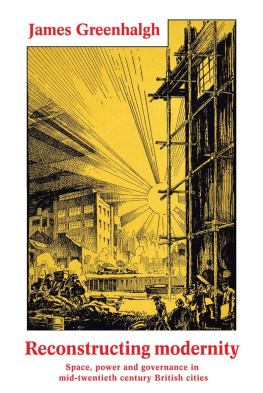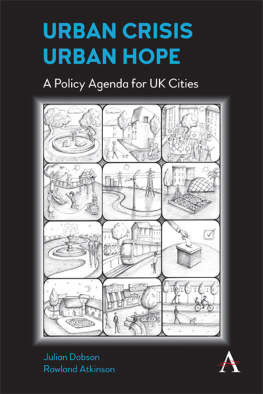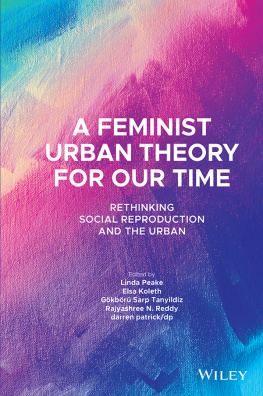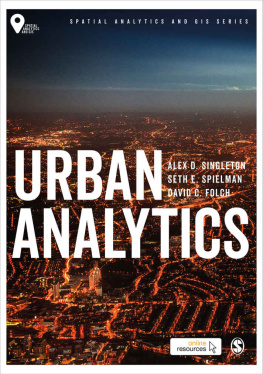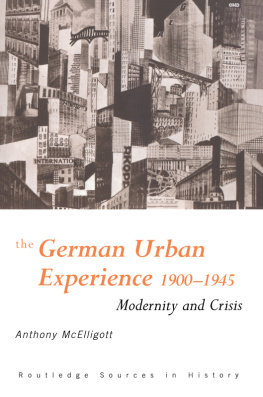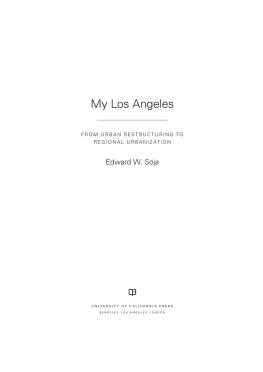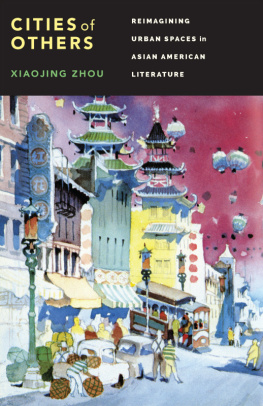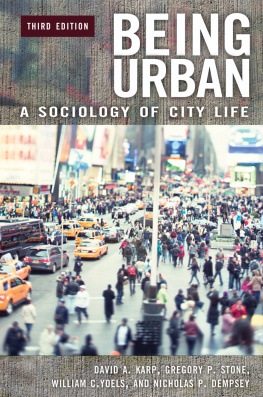THE RUINS OF URBAN MODERNITY

CONTENTS
Chapter 1
EXPLORATIONS AND MAPPINGS
Chapter 2
LEARNING FROM VENICE
Chapter 3
MOVEMENTS AND MACHINES
Chapter 4
THE WHITE CITY
Chapter 5
THE URBAN FRONTIER
Chapter 6
THE UNREAL CITY
Chapter 7
A TALE OF THREE CITIES
Chapter 8
THE DOLEFUL CITY
This book evolved out of research undertaken while I was a fellow at the Ruhr Center of American Studies in the research project SpacesCommunitiesRepresentations: Urban Transformations in the U.S.A. that was funded by the Mercator Research Center Ruhr, and while I was a fellow at the main research area Urban Systems at the University of Duisburg-Essen. I am very grateful to all my fellow researchers and colleagues for sharing their thoughts on my work during that time. Jens Martin Gurr and Randi Gunzenhuser have been very supportive, and I thank both of them for their assistance in the development of my project. I am particularly grateful to Barbara Buchenau, Kornelia Freitag, Jon Hegglund, Thomas Heise, Daniel Stein, Kathy-Ann Tan, and Mabel Wilson for their helpful feedback on individual chapters and aspects of my work. Finally, I wish to thank my family and friends, who have been a constant and invaluable source of inspiration and encouragement.
All references to Thomas Pynchons Against the Day are given parenthetically in the text. While Pynchons ellipses have been included in their original form, authorial omissions are indicated by an ellipsis in square brackets.
Halfway through Pynchons novel, Against the Day (2006), we encounter a small town in the early 1900s. An urban island amid the rural expanses of the American Midwest, it is not quite a town or city in the proper sense. This is, however, less because it would fail to meet certain hard criteria (such as size or density). It is a peculiar form of settlement because, despite being rather recently established, it resembles the afterlife of a human-made environment. Perhaps not even a decade old, it is already a site of ruins:
One day, out in some haze-horizoned piece of grassland, [ ... ] architectural details emerged from the bunchgrass and the dazzle of sky, and soon they were entering Wall o Death, Missouri, built around the remains of a carnival, one of many inspired by the old Chicago Fair. The carnival after a while had moved on, leaving ruins to be converted to local uses, structural members from the Ferris wheel having for miles around been long incorporated into fence, bracing, and wagon hitches, chickens sleeping in the old bunkhouse, stars wheeling unread above the roofless fortune-tellers booth. (476)
The fictional town of Wall o Death only surfaces once in Against the Day, in an episode that is part of a longer section exploring the historical urbanization of the American West. Seemingly of marginal importance for the entire novel, this brief episode succinctly illustrates the way in which Pynchons text reassembles semantic fragments gathered from disparate spatiotemporal imaginaries.
Wall o Death is not built on any old ruins; it is built on the ruins of the city of tomorrow. The wreckage left behind by the carnival is an outgrowth of the 1893 Chicago Worlds Fair (also known as the Worlds Columbian Exposition), for which an ideal citythe so-called White Citywas built from scratch along the Lake Michigan shoreline. The White City stands for a historically new urban paradigm, for a joint venture, as it were, between architectural, utopia
Still, the potential that inheres in ruins is also contingent on the particular gaze that is directed at them. Accordingly, Wall o Death emerges as a reversible figure, indicating a rather contemporary imaginary of ruins. This crystallizes when we look at how the town center is depicted, namely, as a mecca for motorcycling tourists. Wall o Death is actually named after a popular attraction at a former carnival; it was (and still is) a common name for motordromes in which bikers ride along vertical walls and perform dangerous stunts. In Pynchons Midwestern town, such a motordrome is the single structure that temporarily escapes disintegration; the defunct edifice instead becomes the historic core of the new town:
The only structure not fallen all to pieces yet was the Wall of Death itself, a cylindrical wood shell, looking fragile but destined to be last to go, weathered to gray, with ticket booth, stairs winding around, chicken wire that once separated the breathless tip from the spectacle inside. (476)
An emblem of the incipient motor age, this structure must have already been significant when it was still in use. Ironically, then, once falling into disrepair, it remains a powerful symbolic structure, albeit with changed polarity. While performers were once subject to a centrifugal force within the motordrome, it now exerts a centripetal force that draws bikers from all over the country to a site of ruin tourism. The withering arena in the town center, [v]isited by motorcycling pilgrims, as if it was a sacred ruin, scene of legendary daredevilry (476), reemerges as a place of nostalgia for a young generation of ruin-gazers. The nod toward the rise of postindustrial heritage tourism after the Second World War is clearly palpable here.
This anachronistic scenario then acts as a distorting mirror, reflecting the wider transformation of the postwar American urban landscape. This is already implied in the trope of an empty center frequented by motor vehicle enthusiasts. Such imagery figures here as a transmuted vision of suburbanites flocking to a barren inner-city wasteland. This becomes even more distinct when the narrative continues with a shift in perspective that further complicates the image assembled so far. It is an aerial viewthe eye of the cartographerby means of which Pynchons text introduces yet another category of ruin-gazer. Having compared the derelict motordrome with a sacred ruin, the narrator goes on to relate that
when viewed from overhead [it was] reminding widely-traveled aeronauts of ancient Roman amphitheatres strewn across the old empire, empty ellipses at the hearts of ancient fortress towns, the onset of some suburban fatality in the dwellings presently appearing at human random around it, treeless perimeters becoming shaded boulevards astream with wheelfolk and picnickers, while around the dark corners, under the new viaducts, in the passages greased with night, the gray wall, the Wall of Death, persisted in the silence and forced enigma of structures in their vanishing. (476477)
The change in perspective yields a panoramic image in which past and present collapse into each other. As such, the image is most ambivalent. There is indeed an obvious sense of historical demise to it. For the process in which the urban core is drained by the centrifugal force of suburbanization
Against the Day abounds with such narrative miniatures in which historicity and contemporary aesthetic sensibilities bleed into each other. Almost 1,100 pages long, the novel unfolds a complex historical storyworld that is impressive in its geographical scope. Spanning about three decades, Pynchons narrative starts in Chicago in the year 1893 and from there takes us to the American Midwest and West, Mexico, the Arctic, South Africa, Germany, England, France, Belgium, Italy, the Balkans, Inner Asia and, as the books dust jacket blurb has it, one or two places not strictly speaking on the map at all. This sprawling itinerary involves not least a variety of urban spaces, however loosely defined. There are episodes that end up in retro-futuristic flying cities, drowned cities, and legendary lost cities buried under the desert. Still more often, the novel highlights what has come to enjoy widespread recognition as the modern city, that is, the city of industrial capitalism flourishing in the late nineteenth and early twentieth century. Not unlike the case of the rural small town that resembles a postindustrial ruinscape, however, the modern city also exhibits a peculiar untimeliness here. In fact, Pynchon time and again envisions fin de sicle in such a way as to foreshadow the urban condition diagnosed about a century later. The modern city that Pynchon hurls us into thus seems as if it were not on the map at all, because we did not spot it on a map of a century ago. We would rather expect to find such a city on a turn-of- the-twenty-first-century map. Does this 2006 novel then primarily seek to reconsider the past, or does it negotiate the present by reappropriating the past? It seems to me that this work of fiction satisfies both ideas equally. In other words, it challenges received notions of modernity as much as it attempts to interrogate the present by rewriting the past. This nexus is of key significance to



